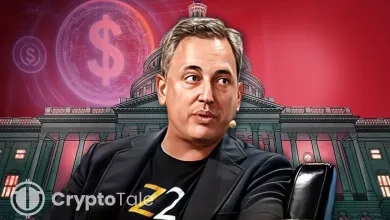OKX CEO and Brian Armstrong Align on Hybrid Finance Push

- OKX CeDeFi rollout is tied to Star Xu and Brian Armstrong’s shared hybrid finance stance.
- The platform’s testing phase includes Passkey access and Magic Spend functionality.
- Expansion will focus on regions with regulatory support and liquidity mechanisms.
Star Xu and Coinbase CEO Brian Armstrong expressed shared support for integrating centralized and decentralized finance models during industry discussions in early October 2025.
Their alignment came as Xu confirmed that OKX will extend its CeDeFi products to additional regions after current testing phases conclude. The remarks followed Xu’s appearance at Token2049 in Singapore on October 1, where he outlined the company’s plans and timeline.
Product Testing and Core Functions
OKX has already begun public testing of its CeDeFi product. The platform introduces Passkey authentication and Magic Spend, which let users trade through decentralized exchanges without wallet switching.
These features aim to merge centralized access with decentralized execution, a concept Armstrong has discussed repeatedly when calling for broader on-chain usability through established platforms.
Notably, Xu said during the Token2049 event that the rollout will focus on users in jurisdictions that support hybrid financial frameworks. He added that CeDeFi tools should reduce friction for individuals entering decentralized markets. This direction aligns with Armstrong’s earlier statements about lowering barriers for regulated access to Web3 financial products.
X Layer Roadmap and Protocol Links
The CeDeFi expansion connects to OKX’s three-phase plan for its X Layer network. Phase one includes USDT integration and access to protocols such as Aave, Uniswap, Balancer and Chainlink. Xu said later phases will support cross-chain functions and additional settlement options.
Armstrong has also argued that centralized exchanges can serve as gateways to decentralized infrastructure if connectivity improves. Xu’s model supports that view by embedding DeFi protocols within a controlled framework. He has previously described the broader objective as moving “everything on chain,” a phrase he used in multiple public remarks throughout September and October.
Compliance and Market Timing
Compliance is important to the rollout. OKX does not intend to stimulate artificial demand for its CeDeFi product. The company instead plans to rely on built-in liquidity mechanisms and transparent systems to meet regulatory expectations in selected regions.
Armstrong has supported similar outlooks when addressing policymakers about responsible growth of digital finance. His public comments over the past year emphasized that hybrid approaches could meet regulatory standards without restricting innovation. Xu’s statements show the same stance, especially regarding market rollout strategies.
Stablecoin growth also factored into the timing. Xu noted in late September that on-chain stablecoin capitalization could reach $1 trillion within two years. Armstrong has noted comparable figures when discussing how asset-backed tokens may support future on-chain financial services. Their combined outlook shows why OKX linked stablecoins to CeDeFi testing from the start.
Related: OKX Enforces Strict AML Controls on Huione Group Activity
Regional Rollout and Industry Context
Xu confirmed at Token2049 that the first set of expansions will target regions with workable regulatory structures. He did not specify the jurisdictions but said testing results will guide the initial deployment. The company plans to continue refining functions such as Magic Spend and Passkey during this period.
Armstrong has used similar arguments when advocating for clearer rules to support cross-border access. His position on regulated innovation aligns with Xu’s approach to selecting early markets for CeDeFi access. The two executives have separately pushed for frameworks that let trading platforms connect users to on-chain tools without bypassing oversight.
Their similar messaging places both Coinbase and OKX among the firms promoting gradual integration of decentralized services through existing infrastructure. It also shows how leadership perspectives across major exchanges are agreeing on hybrid models.
Meanwhile, Star Xu’s agreement with Brian Armstrong on combining centralized access with decentralized functionality shows the company’s next phase. The CeDeFi rollout connects current testing, protocol integration and regional compliance planning. With stablecoin growth and regulatory timing also in view, Xu’s strategy indicates broader industry alignment on hybrid finance.





